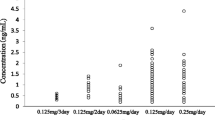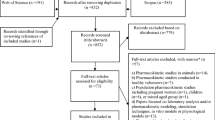Abstract
Background: Optimal use of digoxin in the elderly population requires information about the drug’s pharmacokinetics and the influence of various factors on the drug’s disposition. However, because of sampling restrictions, it is often difficult to perform traditional pharmacokinetic studies in elderly patients.
Objective: This study was conducted to determine the apparent total clearance of digoxin from serum after oral administration (CL/F) and to establish the role of patient characteristics in estimating doses of digoxin for elderly patients (age ≥65 years), using routine therapeutic drug monitoring data.
Methods: Analyses of the pharmacokinetics of digoxin were conducted using the nonlinear mixed-effects modelling (NONMEM®) software, a computer program designed to analyse pharmacokinetics in study populations by allowing pooling of data. Steady-state data (140 observations) obtained by routine therapeutic drug monitoring following repeated oral administration of digoxin in 94 hospitalized elderly patients (age ≥65 years) were analysed to establish the role of patient characteristics in estimating doses of digoxin for elderly patients.
Results: Estimates generated by NONMEM® indicated that digoxin CL/F was influenced by the demographic variables of total bodyweight (TBW), serum creatinine (SCr), age (AGE), presence of congestive heart failure (CHF), concomitant administration of the calcium channel antagonists (calcium channel blockers [CCBs]: verapamil, diltiazem or nifedipine), sex (SEX) and elderly clearance factor (trough serum concentration of digoxin; [Ctrough]^θ). The full version of the final NONMEM® model was CL/F[L/h]=(0.588 × TBW [kg])^(0.189) × SCr[mg/dL]^(−0.163) × (AGE [years]/65)^(−0.152) × 0.957^(CCB) × 0.941^(CHF) × 0.965^(SEX) × Ctrough [ng/mL]^ (−0.180), where CCB is 1 for concomitant administration of a CCB and is 0 otherwise; CHF is 1 for patients with CHF and is 0 otherwise; SEX is 0 for male and is 1 for female; and the elderly clearance factor Ctrough −0.180 is 1 for digoxin Ctrough <1.7ng/mL.
Conclusions: We developed a new model for elderly patient dosing of digoxin with good predictive performance. Clinical application of the findings of the present study to patient care may permit selection of an appropriate initial digoxin maintenance dose, thus enabling the clinician to achieve a desired therapeutic effect. However, the digoxin dosage regimen should be based on an appraisal of the individual patient’s clinical need for the drug.











Similar content being viewed by others
References
Wagner JG. Appraisal of digoxin bioavailability and pharmacokinetics in relation to cardiac therapy. Am Heart J 1974; 88: 133–8
Mooradian AD. Digitalis: an update of clinical pharmacokinetics, therapeutic monitoring techniques and treatment recommendations. Clin Pharmacokinet 1988; 15: 165–79
Yukawa E, Mine H, Higuchi S, et al. Digoxin population pharmacokinetics from routine clinical data: role of patient characteristics for estimating dosing regimens. J Pharm Pharmacol 1992; 44: 761–5
Yukawa E, Honda T, Ohdo S, et al. Population-based investigation of relative clearance of digoxin in Japanese patients by multiple trough screen analysis: an update. J Clin Pharmacol 1997; 37: 92–100
Beal SL, Sheiner LB, editors. NONMEM user’s guides (1992-2006). Ellicott City (MD); Icon Development Solutions, 2008
Sheiner LB, Benet LZ. Premarketing observational studies of population pharmacokinetics of new drug. Clin Pharmacol Ther 1985; 38: 481–7
Ishii T, Ohisa N, Karino A, et al. Fundamental study of CEDIA digoxin plus assay and CEDIA theophylline assay on the Hitachi-7070 analyzer. J Clin Lab Inst Reag 1996; 19: 171–7
Iisalo E. Clinical pharmacokinetics of digoxin. Clin Pharmacokinet 1977; 2: 1–16
Aronson JK. Clinical pharmacokinetics of digoxin 1980. Clin Pharmacokinet 1980; 5: 137–49
Yukawa E, Suematsu F, Yukawa M, et al. Population pharmacokinetics of digoxin in Japanese patients: a 2-compartment pharmacokinetic model. Clin Pharmacokinet 2001; 40: 773–81
Sheiner LB, Rosenberg B, Marathe V. Estimation of characteristics of pharmacokinetic parameters from routine clinical data. J Pharmacokinet Biopharm 1977; 5: 445–79
Morselli PL, Assael BM, Gomeni R. Digoxin pharmacokinetics during human development. In: Morselli PL, Granttini S, Sereni F, editors. Basic and therapeutic aspects of periental pharmacology. New York: Raven Press, 1975: 377–92
Sheiner LB, Beal SL. Some suggestions for measuring predictive performance. J Pharmacokinet Biopharm 1981; 9: 503–12
Bauer LA, Horn LR, Pettit H. Mixed effect modeling of detection and evaluation of drug interaction: digoxin-qunidine and digoxin-verapamil combinations. Ther Drug Monit 1996; 18: 46–52
Rameis H, Magometschnigg D, Ganzinger U. The diltiazem-digoxin interaction. Clin Pharmacol Ther 1984; 36: 183–9
Belz GG, Aust PE, Munkes R. Digoxin plasma concentrations and nifedipine. Lancet 1981; 1: 884–5
Boden WE, More G, Sharma S, et al. No increase in serum digoxin concentration with high-dose diltiazem. Am J Med 1986; 81: 425–8
Schwart JB, Raizner A, Akers S. The effect of nifedipine on the serum digoxin concentrations in patients. Am Heart J 1984; 102: 669–74
Zhou XD, Gao Y, Guan Z, et al. Population pharmacokinetic model of digoxin in older Chinese patients and its application in clinical practice. Acta Pharmacol Sin 2010; 31: 753–8
Hanratty CG, McGlinchey P, Johnston GD, et al. Differential pharmacokinetics of digoxin in elderly patients. Drug Aging 2000; 17: 353–62
Gheorghiade M, van Veldhuisen DJ, Colucci WS. Contemporary use of digoxin in the management of cardiovascular disorders. Circulation 2006; 113: 2556–64
Acknowledgements
No sources of funding were used to assist in the conduct of this study. The authors have no conflicts of interest that are directly relevant to the content of this study.
Author information
Authors and Affiliations
Corresponding author
Rights and permissions
About this article
Cite this article
Yukawa, M., Yukawa, E., Suematsu, F. et al. Determination of Digoxin Clearance in Japanese Elderly Patients for Optimization of Drug Therapy. Drugs Aging 28, 831–841 (2011). https://doi.org/10.2165/11594230-000000000-00000
Published:
Issue Date:
DOI: https://doi.org/10.2165/11594230-000000000-00000




